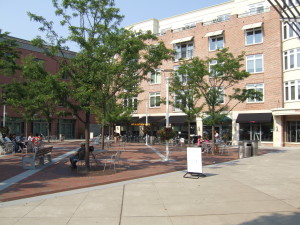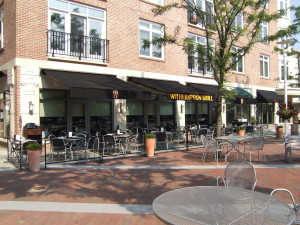New Jersey Land Use
now browsing by category
Site Plan Drawings
 While I’ve discussed the site planning process in New Jersey on my web site and in earlier blog posts, I haven’t provided any images to provide greater clarity to my readers. In this post I have provided several sheets of drawings from a site plan that I was involved with during my term as Municipal Engineer for the Borough of Princeton. The drawings included in this blog relate to the construction of two buildings and a public courtyard. The building in the foreground is five stories high with commercial space on the first floor and apartments above. The public space sits between the apartment building and the street and is bordered on its left by a new public library which was built under a separate contract.
While I’ve discussed the site planning process in New Jersey on my web site and in earlier blog posts, I haven’t provided any images to provide greater clarity to my readers. In this post I have provided several sheets of drawings from a site plan that I was involved with during my term as Municipal Engineer for the Borough of Princeton. The drawings included in this blog relate to the construction of two buildings and a public courtyard. The building in the foreground is five stories high with commercial space on the first floor and apartments above. The public space sits between the apartment building and the street and is bordered on its left by a new public library which was built under a separate contract.
The library, apartment building and parking garage were constructed on a site that had once housed a coal gas manufacturing facility which operated in the latter part of the 19th and earlier part of the 20th centuries. Prior to the redevelopment, it was home to a smaller library building and a 180 car surface parking lot.
 I’ve provided a few of the drawings included in the full site plan set which was presented to the Princeton Regional Planning Board for review. You will note that some of the drawings have been prepared by a Registered Architect while others have been designed by a Professional Engineer and all are based upon a current property survey performed by a Licensed Professional Land Surveyor. You can find more information about these requirements in the building and zoning tab at the top of this page. Each of these documents must contain the information specified in the town’s Major Site Plan Checklist – the checklist requirements will vary from municipality to municipality.
I’ve provided a few of the drawings included in the full site plan set which was presented to the Princeton Regional Planning Board for review. You will note that some of the drawings have been prepared by a Registered Architect while others have been designed by a Professional Engineer and all are based upon a current property survey performed by a Licensed Professional Land Surveyor. You can find more information about these requirements in the building and zoning tab at the top of this page. Each of these documents must contain the information specified in the town’s Major Site Plan Checklist – the checklist requirements will vary from municipality to municipality.
The information that is required for a site plan today is so voluminous that different types of information are often shown on different sheets for clarity. In these samples we find that the Site plan shows the overall layout of buildings, walkways and landscaping. The Grading Plan focuses on the existing and proposed elevations of the surface of the project site. The Utility plan identifies the locations and in some cases elevations of the site utilities such as water supply piping, sanitary sewers, gas services, electric feeds, communication cables, drainage piping and structures and sometimes more.
Site Plan – Princeton Redevelopment Project
Grading Plan – Princeton Redevelopment Project
Utility Plan – Princeton Redevelopment Project
The Soil Erosion and Sediment Control Plan describes the measures that must be undertaken during construction to prohibit the migration of soil off the site by the actions of wind, water and construction vehicles.
Soil Erosion and Sediment Control Plan – Princeton Redevelopment Project
The floor plan and building elevations provide a fairly detailed view of how the interior spaces will be used and what the exterior of the building will look like when completed. The building plans have not generally been fully designed prior to the Planning or Zoning Board approval due to the cost of developing detailed construction documents. Therefore, it’s likely that some changes will be required before the project is completed. It’s very important to review any required changes with the municipal staff. In some cases the staff may sign off on changes to your plan but on other occasions you will be required to return to the board for authorization.
Floor Plan – Princeton Redevelopment Project
West Elevation – Princeton Redevelopment Project
I hope that this brief summary will shed a bit more light on the information required to obtain Major Site Plan Approval under New Jersey’s Municipal Land Use Law.
The author, Carl E. Peters is one of fewer than 10 people licensed by the State of New Jersey as a Professional Engineer, Professional Land Surveyor, Professional Planner, Construction Official, Building Subcode Official and Plumbing Subcode Official. He is also a Certified Municipal Engineer and Mediator and founder of Carl E. Peters, LLC
What is a Site Plan?
Many people arrive at my web site by searching for the answer to the question “What is a Site Plan”? Here is a somewhat simplified answer to that question for projects situated in the State of New Jersey, although I suspect much of this explanation will be true for other states.
A site plan is a plan to develop one or more lots, usually to construct a building or structure of some sort along with the other improvements to the property that support the new building. These improvements may include:
Utility services – gas, electric, water, sewer, telephone, cable, etc.
Driveways and parking lots;
Walkways and means of ingress and egress;
Drainage systems;
Signs;
Lighting;
Landscaping, and more.
In New Jersey, the term site plan is not usually associated with the development of individual one and two family dwellings on existing lots as these projects do not require Planning Board approval. Otherwise the term is accurate for those types of project, as well.
The plan must start out with a detailed survey of the property, performed by a Professional Land Surveyor, who will locate the existing features on the property and depict them on a survey plat. The information required to be shown on the existing conditions survey is generally contained in the check list requirements enumerated in the municipality’s land use ordinance. In addition, the Professional Land Surveyor must prepare the survey in accordance with the laws and regulations that govern the preparation of land surveys in New Jersey.
The applicant’s Architect and Professional Engineer then design the layout of the buildings and other improvements on the site while working within the constraints set forth in the local Zoning Ordinance, such as, allowable building size, minimum setbacks from the property lines for the building and site improvements, required number of parking spaces and more.
A set of Site Plan drawings normally includes some sheets that are “bird’s eye” views of the property, showing both the existing conditions as well as the proposed improvements. Often, due to the large amount of information required on these drawings, individual sheets are provided for specific subject matters, e.g. Grading Plan, Lighting Plan, Landscaping Plan, Utility Plan. The applicant may also be required to show floor plans of the building as well as building elevations and building renderings so that the reviewing board can visualize what the completed project will look like. Similarly, details of the site improvements are generally included. Full building details, structural, electrical and plumbing plans are not usually requested.
It is always important to have an experienced team of professionals to assist you in preparing a site plan for your building project. If you would like more information about the development process in the State of New Jersey please visit my web site www.carlepeters.com or email me at cpeters@carlepeters.com.
NJ Municipal Land Use Jurisdiction Table
I recently taught a class about NJ Municipal Land Use Law and the NJ Residential Site Plan Standards to a group of Professional Land Surveyors. There were some questions about how to know which group has the authority to make decisions about land use matters in the State of NJ. I have attempted to provide a quick reference of these jurisdictional issues in the attached table.
The author, Carl E. Peters is one of fewer than 10 people licensed by the State of New Jersey as a Professional Engineer, Professional Land Surveyor, Professional Planner, Construction Official, Building Subcode Official and Plumbing Subcode Official. He is also a Certified Municipal Engineer and Mediator and founder of Carl E. Peters, LLC

 D5 Creation
D5 Creation